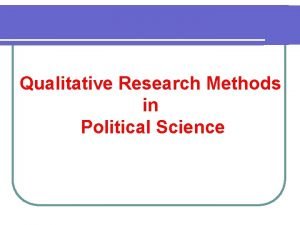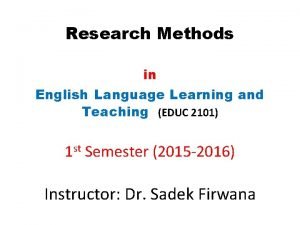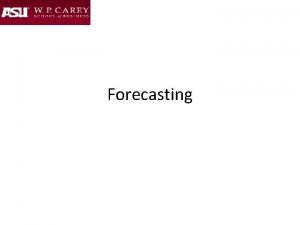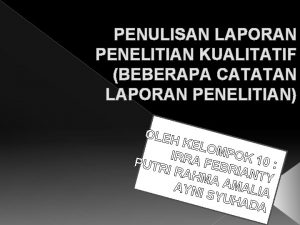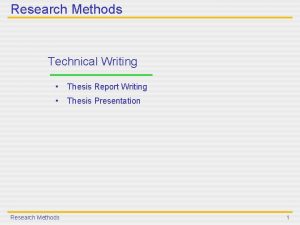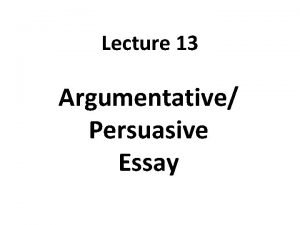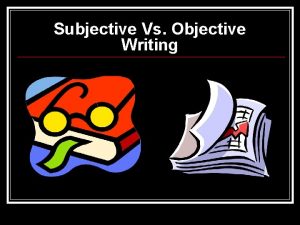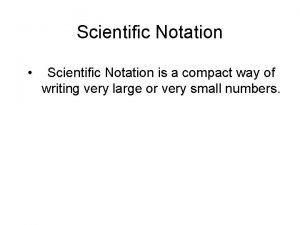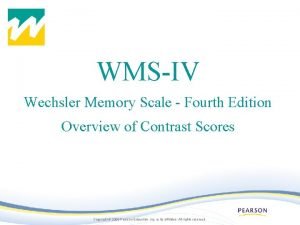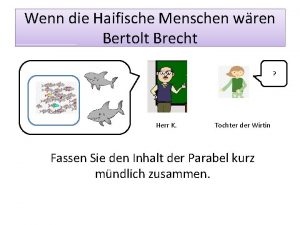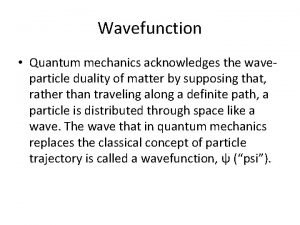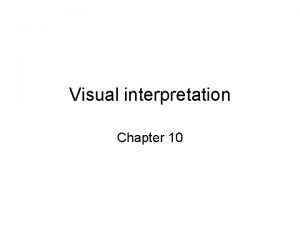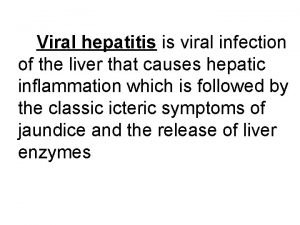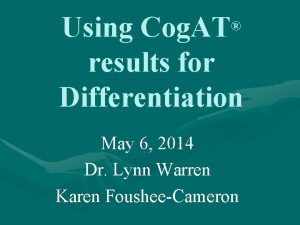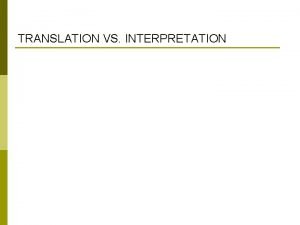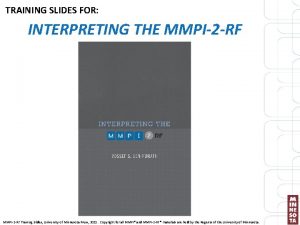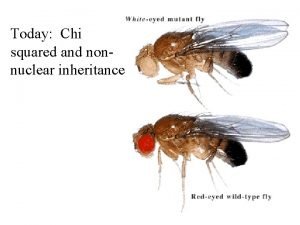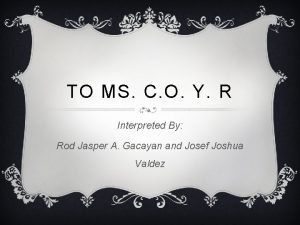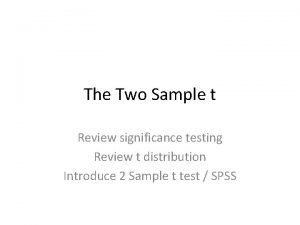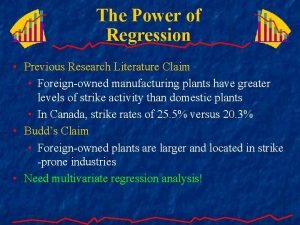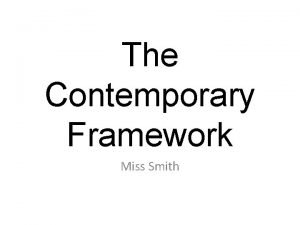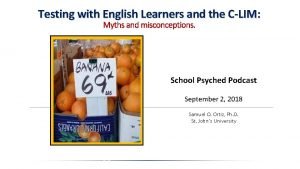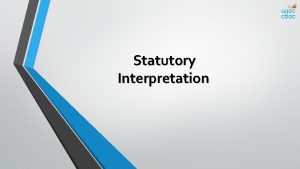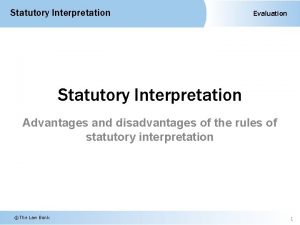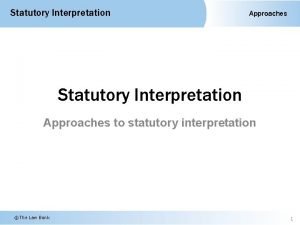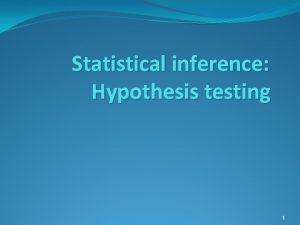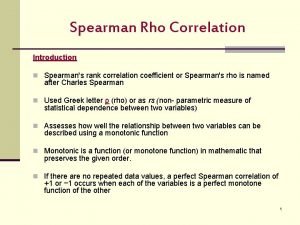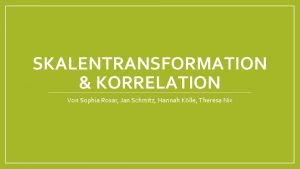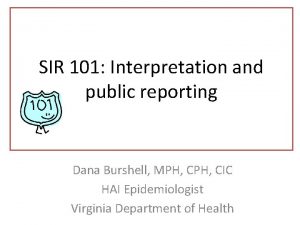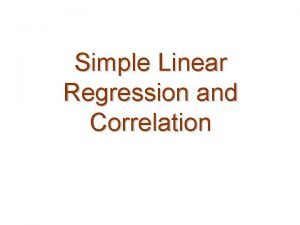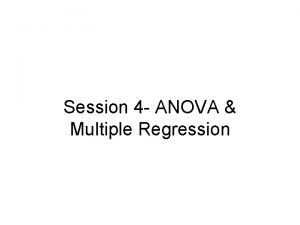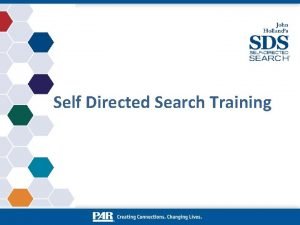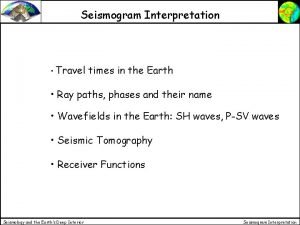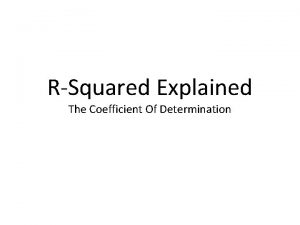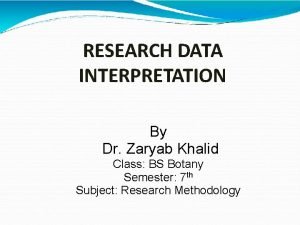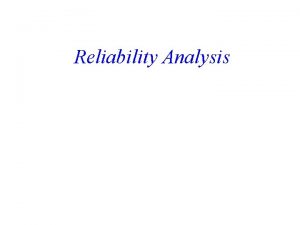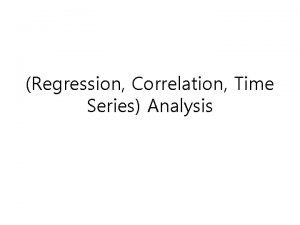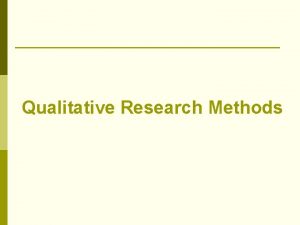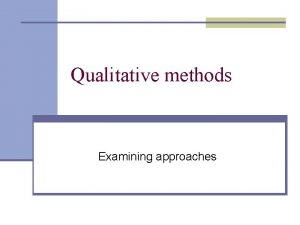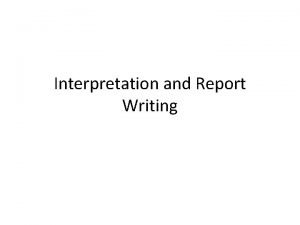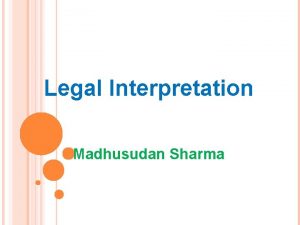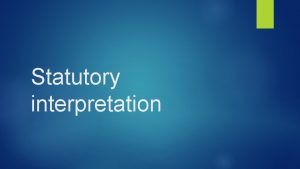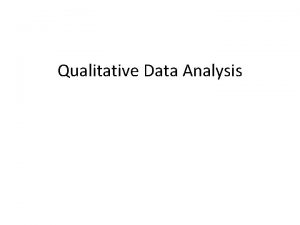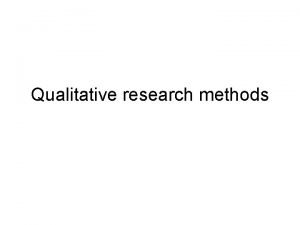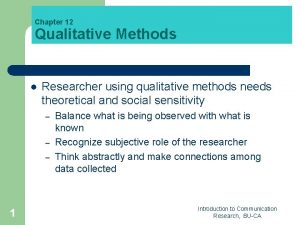Qualitative Methods Part II Interpretation Writing it up

















































































- Slides: 81

Qualitative Methods Part II: Interpretation & “Writing it up” Barret Michalec, Ph. D University of Delaware ACE Symposium: 1/14/16

Qual Methods: ACE • Last session: – Overview of types of qualitative methods (e. g. interviews, observations, PAR, etc. ) – Highlighted potential benefits as well as pitfalls and hurdles associated with these methods – Discussed data gathering tools, tips • This session: – – Gathered data time to analyze & write up sections Examples of published “Methods” sections Examples of published “Results” sections Coding/analysis steps

Analysis = “Coding”

What is “Coding”? • It organizes, it manages, it compares, and it retrieves • “Codes are labels that assign symbolic meaning to the descriptive or inferential information compiled during a study” • “Codes usually are attached to data ‘chunks’ of varying size and can take the form of a straightforward, descriptive label of a more evocative and complex one (e. g. , a metaphor)” • “essence-capturing” • “Critical Link” b/w data collection and their explanation of meaning • “Researcher-generated construct” – For: pattern detection, categorization, theory building, and other analytical purposes • Condensing bulk of data into analyzable units by creating categories (that make sense) with and from data • Coding IS analysis BUT it is just ONE ASPECT of analysis – it is not THE analysis

What is Coding? • You want to be able to build relationships, uncover themes the linkages are the key • “codes” usually are attached to “chunks” of varying size – words, phrases, sentences, or whole paragraphs, connected or unconnected to a specific setting” • Can be thought of as “data reduction or simplification” – Can be real basic but you guys are better than that • Can be thought of as “data complication” – Expand, transform, reconceptualize data means of understanding what you are seeing • DECONTEXTUALIZING: Break it done to build it back up usually a mix of reduction and complication

What is Coding? • Key to coding is your use of reflection you are the “tool” in this process • “Codes are organizing principles that are NOT set in stone” – they are not static • Coding as a filter • “Coding is never a mechanistic activity”

Coding is a multi-step/stage PROCESS with many facets

What is Coding? • Coding is a heuristic – a method of discovery – Interpretivist and intimate • Miles, Huberman, & Saldana: – First Cycle: working “chunks”, bulky – Second Cycle: more refined, working with results from First Cycle

“Cycles”

• A word about MHS’s “breakdown” of coding methods:

First Cycle Coding: Elemental • Descriptive Coding: just like it sounds think Qualitative description – Good for environments/settings • In Vivo Coding: uses words or phrases from participants own language as codes (folk and indigenous terms) – Look for repeats – Not to be confused with NVIVO (coding software) • Process Coding: uses “ing” words to connote observable and conceptual action in the data – “Processes also imply actions intertwined with the dynamics of time, such as things that emerge, change, occur in particular sequences, or become strategically implemented” – Action/Interaction and consequences

First Cycle Coding: Affective • Emotion Coding: just like it sounds affect states/emotions of participants (and researcher) can involve In Vivo coding • Values Coding: – Value: importance we attribute to ourselves, others, thing, idea…. – Attitude: way we think and feel about ourselves, others, thing, idea… – Belief: part of a system that includes values and attitudes, plus personal knowledge, experiences, opinions, prejudices, morals, personal perceptions of world • Evaluation Coding (not so sure I put it in this category) – Judgments about merit, worth, significance of programs and policy – **So many different parts to this though (so many different elements of programs)

First Cycle Coding: Literary & Language • Dramaturgical Coding: applies to terms and conventions of character, play script, and production analysis onto qual data – Power relationships, interpersonal experiences, processes of human motives and agency

First Cycle Coding: Exploratory • Holistic Coding: applies a single code to a large unit of data (big chunks) to capture a sense of the overall contents and possible categories (rather than line by line) • Provisional Coding: begins with a “start list” of researcher-generated codes – based on preparatory investigation suggests might appear in the data (b/f they are collected analyzed) – Deductive – Could also be taken from prev lit • Hypothesis Coding: application of researcher-generated, predetermined list of cods on qual data specifically to assess a researcher-generated hypothesis – Dev’p from theory/prediction about what will be found in data b/f collected analyzed – deductive

First Cycle Coding: Procedural • Protocol Coding: according to pre-established, recommended, standardized, or prescribed system – Field-tested coding schemas – or just established coding schemas that you are applying across data • Causation Coding: looking at “why” particular outcomes come about – Mapping pathways – Good for grounded theory approach

First Cycle Coding: Grammatical • Attribute Coding: notation of basic descriptive info such as the fieldwork setting, participant characteristics or demographics, data format, etc – Basically must trumped up note taking (or boiled down Descriptive Coding) to keep you informed about what you did/where you did it • Magnitude Coding: Supplemental alphanumeric or symbolic codes or subcodes applied to existing coded data or a category to indicate their frequency, intensity, direction, presence, or evaluative content – Words vs Numbers – Frequency analysis issues

First Cycle Coding • Subcoding: don’t think it should be lumped into Grammatical – Process of refining, clarity next Cycle, but can definitely be done during First Cycle

First Cycle Coding • Simultaneous Coding: again, it’s own process, I don’t think it can be lumped in with Grammatical – Application of two or more different codes to a single qual datum, or the overlapped occurrence of two or more codes applied to data “chunk” – Requires good “eye” and training/experience – Need to be loose and open

So Many Coding Methods • KEY: Your research questions, your research topic • Probably will use a combo of many of these coding methods and not even know it • BUT: these are good to know to understand what you are doing and that you are focused on particular “things” at particular times • I have probably seen 1 or 2 papers that talk specifically about their coding methods (“Using descriptive coding…. . ” “Applying a Values coding approach…”) • I personally do not think “Oh, I’m process coding now”, I just code. – But it ALL depends on my research questions what I am “looking for”

DON’T FORCE

Creating/Developing Codes • Deductive: list comes from conceptual/predetermined framework – List of questions, hypotheses, problem areas/gaps, key variables, key theoretical concepts • Inductive: codes emerge progressively during data collection – Grounded in data rather than force fit predetermined codes – Also referred as “open” coding • You are “open” to the data • Revising Codes: You will b/c codes “Decay”, grow, refine and you MUST adapt as the analyzer • Coding Scheme: not a catalog of disjointed descriptors but rather a conceptual web, including larger meanings and their constructive characteristics • Code Book: Keep one – – Definitions Long and short hand of codes if they fit within particular categories Use in tandem with memos and “jottings” Will change over time, probably go through a few versions

Memoing & Jotting • Perhaps the most important part of coding • Another form/part of analysis essential

Second Cycle • Finding the patterns, reoccurring categories – Then using these (“pattern codes”) to find emergent themes, theories, explanations • Pattern Coding: – Generating: looking for threads/links that tie bits together Looking for commonalities – Don’t go here first! Don’t rush – Happens quickly b/c of what we habitually process information (don’t get LOCKED, stay loose) • • Categories or themes Causes/explanations Relationships among people Theoretical constructs

DON’T FORCE

Pattern Coding • Use your code book • Remember your memoing will help you write how it all happened • Remember your memoing keep track of how things dev’p (according to you) • Example: “Knowledge Gap” & “Calm b/f Storm”

The Process of Coding • There’s more than one way to skin a cat but you have to start somewhere • Memo, memo • Pre-Code activities (read…. or not) • What can/should be coded? What do you think it depends on? – This will be your demise • Garbage in = Garbage out • “Pools of Meaning” Patterns • Decontextualizing Recontextualizing • What I like to call the “Goldilocks Dilemma” – Codes too general, Codes too specific equally problematic

YOU are the “tool” in Coding • “We construct our codes b/c we are actively naming data – even when we believe our codes form a perfect fit with action and events in the studied world” – “We may think our codes capture the empirical reality. Yet it is our view: we choose the words that constitute our codes. Thus we define what we see as significant in the data and describe what we think is happening. ” – The key is the continual interactions w/ the data and with the participants – as we define and refine our codes we try to see the participants’ views and actions from their perspective

• • Frustrations are good Anxiety is your friend Struggles are essential If this was “easy” everyone would do it

“Writing Up”: Qual Methods

Wolcott • “Qualitative approaches beckon because they appear natural, straightforward, even ‘obvious’, and thus easy to accomplish. Were it not for the complexity of conceptualizing a qualitative study, conducting the research, analyzing it, and writing it up, perhaps they would be. ” • Writing: – – Where do you do it and why What time do you do it and why Do you have a ritual Do you keep to a routine


Wolcott • Analysis – “Data subjected to analysis are examined and reported through procedures generally understood and accepted in that everyday world, among social as well as not-so-social scientists. The reliability (in any sense of the word) of such procedures derives from the standardization of procedures, not their rightness or wrongness, nor even their appropriateness. ”

Wolcott • Interpretation – “Interpretation, by contrast, is not derived from rigorous, agreed-upon, carefully specified procedures, but from our efforts at sense-making, a human activity that includes intuition, past experiences, emotion – personal attributes of human researchers that can be argued endlessly but neither proved nor disproved to the satisfaction of all. Interpretation invites the reflection, the pondering of dat in terms of what people make of them. ” – “Analysis falls more on the scientific side of things, interpretation on the more humanistic side. ”

Wolcott • “A clear statement of purpose(s) is critical for deciding what data need to be reported, what needs to be counted, what relevant literatures to cite or measures to use, and how broadly to draw implications or recommendations from one’s research” – The purpose of this study is…. . – I say concise RQ(s) does the same • “When you do turn to analysis, make the dimension of your study as strong and as systematic as possible, the justification for your effort. Be factual in what you report; save the controversial or contestable for your interpretative comments. You might think of the analysis you offer as earning merit that you can later redeem for the opportunity to offer your interpretations. ” – “Sometimes, members of a dissertation committee may flat out advise that they are far less interested in what you make of things than with the original data you present and your tentative, close-to-the-vest analysis of those data. ”

Sparingly / Strategically Fully / Heavily PEERS PROGRAM/ CLUB Emotional Informational Tangible (in & outside of program/club Advising/ Mentoring Shadowing / Research Formal Informal (faculty, staff, physicians) - Intimate (one-on-one) advising -Key Player(s) -Real-life advising - Eliminates fear & hesitancy from students in speaking with faculty - General advising = poor - High School to College Transition (peers) -Intimate (one-on-one) advising -Key Player(s) -High School to College Transition -“Lived” knowledge -Eliminates fear & hesitancy from students in speaking with faculty Stigma associated with using these programs: A. Vulnerability B. Being part of “the hype” Emotional Informational Tangible -Key Player(s) -Micro-Society -Distancing / Knowledge Gap -Competition -“Myth” of one true path -Stories -Knowledge of programs -Intimate Advising Perception of those who leave the path: A. “Didn’t really want it” B. “Didn’t want to put in the work”

Interpretation • Interpretation – Do not over interpret – When you over interpret or over extend yourself your interpretation becomes “thin” • Want “meat” – Don’t “Jump” • Start talking about your concept/category/theme and then discuss something that you think seems relevant but just distracts from your original discussion – Setup your points then knock them down – Do not try explain everything you found • • 1 topic 1 phenomenon 1 theme 1 category – Miles, Huberman & Saldana

Miles, Huberman, & Saldana • Holistic Fallacy: Interpreting events as more patterned and congruent than they really are, lopping off the many loose ends of which social life is made – that is, sloppy research • Elite Bias: Overweighting data from articulate, well-informed, usually highstatus participants and underrepresenting data from less articulate, lower status ones • Personal Bias: The researcher’s personal agenda, personal demons, or personal “axes to grind”, which skew the ability to represent and present fieldwork and data analysis in a trustworthy manner • Going Native: Losing your perspective or your “bracketing” ability, being co-opted into the perceptions and explanations of local participants – Researcher/advocate

Miles, Huberman, & Saldana • • • • Checking for representativeness Checking for researcher effects Triangulating Weighting the evidence Checking the meaning of outliers Using extreme cases Following up surprises Looking for negative evidence Making if-then tests (almost like theory making) Ruling out spurious relations Replicating a finding Checking out rival explanations Getting feedback from participants

Miles, Huberman, & Saldana • “And when we read the reports, the are most often heavy on the “what” (the findings, the descriptions) and rather thin on the “how” (how you got to the “what”). In most cases we don’t see a procedural account of the analysis explaining just how the researcher got from 500 pages of field note to the main conclusions drawn. Researchers are not being cryptic or obtuse. It’s just that there are few guidelines for explaining to their colleagues hat they did, and how. (And, in all fairness, the page limit for journal articles also forces researchers to briefly sketch their methodology paragraphs)”

Miles, Huberman, & Saldana • Central RQ • Lit Review • Conceptual/Theoretic al framework • Methods – Participants – Study setting – Data collection methods – Data analysis procedures • Which kinds of Qual design did you use? • • • How are sample decisions made? What does instrument look like – how do you know it’s valid? How did fieldwork proceed? How are data aggregated, condensed, partitioned, displayed, analyzed, and interpreted? How did you get from all those fieldnotes, Ints, Obs notes, to final report?

Miles, Huberman, & Saldana • Make running notes of Procedural Steps – Bullet Point suggestions on Assignment 3 – Note EXACT decision rules/points • Make them explicit – “Theme was coded as present for a participant if mentioned repeatedly or with strong affect during the interview” – Track Analysis Operations – MY EXAMPLES

Holliday • Notion of “Cautious Detachment” – Hedging (suggest, appear to, seem to) – Setting a Cautious scene (in many cases, often, many of which) – Making restrained sense (for instance, data such as, at other times. . ) – Being careful with people’s words • Different approaches to interpretation • Suspending judgment • Have an “Exit” Strategy My findings are my findings, I don’t care if they caused your house to explode.

Interpretation and your ARGUMENT

Holliday Chapt. 5 • 3 Components to writing about data – 1. ) The Argument: • major driving force of the data discussion • Says what has been found – what the researcher now believes as a results of the data analysis • Provides storyline which gives structure to data Discussion – 2. ) Data Extracts: • Taken from the body of the data and deployed strategically to provide evidence to support the argument – 3. ) The Discursive Commentary: • Tells the reader which bits of each data extract are significant and why – Shows reader how they provide specific evidence to support the argument

Holliday Chapt. 5 • Theme – The basis upon which the Argument, the Data Extracts, and the Discursive Commentaries are organized – Providing organization of writing (headings, stages, etc. )


Approaches to Organizing Writing • A set of individual case studies, followed by a discussion of differences and similarities b/w cases • An account structured around the main themes identified, drawing illustrative examples from each transcript (or other text) as required • A thematic presentation of the findings, using a different individual case study to illustrate each of the main themes

Holliday Chapt. 5 • “It is essential that we are aware that the ‘representation of reality, whether on note cards or in chapter headings’ which is produced by the research [researcher] should not be ‘confused’ with the social reality that inspires the research” • So may be tempted to keep date as “pure” or “raw” as you can

• “It is essential to success in writing about data to understand why raw data cannot simply be left as it is, and why the researcher must organize it and develop a strategy for writing about it. ” – Appreciate that your data is already different than the social reality it is taken from (not “true” representation) WHY NOT? – Therefore, must demonstrate EXPLICITLY how it was constructed METHODS!! – If little more than the raw data is presented then your argument is NOT presented • What is the POINT? !? if the point is not clear then what was the point?

Holliday Chapt. 5 • “Often themes have been growing within the researcher’s mind through the whole research process. Researchers often know the character of their data regardless of any formal analysis. It is after all largely a product of their own thinking during the process of collecting and recording” – Collecting and recording influenced by researchers ‘own background and latent theory’

Holliday Chapt. 5 • Theme – The basis upon which the Argument, the Data Extracts, and the Discursive Commentaries are organized – Providing organization of writing (headings, stages, etc. )


The Argument • “Much scholarly writing consists of arguments – whether explicit or implicit. Ostensibly straightforward data analyses rely on arguments and invoke rhetorical devices to form them. We persuade readers to accept a new theory or interpretation. We convince researchers that we have solid data and sound analyses. A strong argument persuades the reader to accept the writer’s viewpoint. ” The “So What? ” Factor

The Argument • You will have to wrestle with your material • You create your argument from points embedded in your analysis • It is WORK, it will not come easy but it’s fun

The Argument • Questions to help you find Argument(s): – What sense of this process or analysis do you want your reader to make? – Why is it significant ? • You have to make this explicitly clear do not assume the reader knows what you know – What did you tell your readers that you intended to do? Why did you tell them that? – In what sentences or paragraphs do your major points coalesce? – And yes – you will have sub-arguments, but assess how closely they are aligned with your main arguments

Themes & Theories • A thematic analysis is not so different than the presentation of a grounded theory • So same “principles” apply – Argument, Data Extracts, Discursive Commentary • Where do think the differences are?

Plagues • • • Vague Statements Over-generalizations Logical Gaps Weak arguments Leaps Forces • Laziness

DATA

Grounded Theory Glaser, Strauss & Charmaz

Grounded Theory: Glaser & Strauss • Discovery of theory from data (generating) – Provides: relevant predictions, explanations, interpretations, applications – From data systematically obtained from social research • A general method of comparative analysis • Main focus (overemphasis) has been – verification (testing) of theories – Hence a de-emphasis on discovery/generating • Conflict b/w primacy and purpose – Desire to generate – Training to verify • With “desire to generate” often taking a back seat – If not No Seat

Grounded Theory: Glaser & Strauss • Intimately linked to data • “Destined to last despite its inevitable modification” • “. . the adequacy of a theory for sociology today cannot be divorced from the process by which it is generated” – What is this Process? How was it Generated? • Where do we learn this or how to do you show this? ? ?

Grounded Theory: Glaser & Strauss • Theory is not generated out of thin air where do they suggest is “come” from? • Why could it be considered a theory “for the people”? – “We contend also that it does not take a ‘genius’ to generate a useful grounded theory”

Grounded Theory: Glaser & Strauss So what is this notion of “grounded theory” mean? What is theory grounded in?

Grounded Theory: Glaser & Strauss • “Generating a theory involves a process of research” – So have you done when you have “generated” this theory? Theory you have generated

Grounded Theory: Glaser & Strauss • The Four (at least) Highly Interrelated Principles – Fit (Fit-ness) But what do these mean? – Understandable – General – Control (controllable & access variables)

Grounded Theory: Charmaz • “Grounded theory methods foster seeing your data in fresh ways and exploring your ideas about the data through early analytic writing” • “By adopting grounded theory methods you can direct, manage, and streamline your data collection and, moreover, construct an original analysis of your data” • “. . grounded theory methods consist of systematic, yet flexible guidelines for collecting and analyzing qualitative data to construct theories ‘grounded’ in the data themselves. ” – “The guidelines offer a set of general principles and heuristic devices rather than formulaic rules. ” • Thoughts?

Grounded Theory: Charmaz • Remember Glaser & Strauss What do they mean by “Generating a theory involves a process of research”? – So are you done when you have “generated” this theory? – How is this like Charmaz’s early points?

Grounding Theory: Charmaz • Study early data separate, sort, and synthesize = coding – Attach labels to segments of data that depict what each segment is about – Coding distills the data makes it manageable • Note taking/Memoing (about codes) • Constant Comparisons • Continued analysis • “Building levels of abstraction” – “Our work culminates in a ‘grounded theory’, or an abstract theoretical understanding of the studied experience”

Grounded Theory: Charmaz • According to Charmaz how does the work culminate into ‘grounded theory’ Codes…. back to data/research…. codes…. back to data/research

Grounded Theory: Charmaz • According to Charmaz synthesis of G & S – Simultaneous involvement in data collection and analysis – Constructing analytic codes and categories from data, not from preconceived logically deduced hypotheses – Using the constant comparative method, which involves making comparisons during each stage of the analysis – Advancing theory development during each step of data collection and analysis – Memo-writing to elaborate categories, specify their properties, define relationships b/w categories, and identify gaps – Sampling aimed toward theory construction, not for population representativeness – Conducting literature review AFTER developing an independent analysis

Grounded Theory: Charmaz (G & S) • Key Control of research process – Increase analytic power of work • Is the use of Grounded Theory ever “complete”

Grounded Theory: Charmaz (G & S) • What do they mean: marrying of Columbia University positivism and Chicago school pragmatism? – How does the Symbolic Interactionist Perspective fit? • What happened to Glaser and Strauss, according to Charmaz? – How does/did this impact the idea of “Grounded Theory”? – Who is this Corbin character • Is she the Angelina Jolie to Brad (Strauss) and Jennifer (Glaser)? • Are (neo) grounded theorists “Sell outs” (compared to G & S’s original notions)? – Or have people just picked up what they wanted and run with it? – Is it TOO “Flexible” • Is it too “for the people” – What does Charmaz think?

Grounded Theory: Charmaz (G & S) • Charmaz does distance herself from G & S how? In what way? • Fig. 1. 1 Thoughts? Let them……. . do grounded theory? • Has Charmaz muddied the waters? – Or did she just give it back to “the people”? • “Fit and not force” motto that can be generated from tenets of GT – What does it mean? – What does it mean in the early stages of research?

Grounded Theory: Charmaz • “…your research adventure begins with finding data. Discover how exciting empirical research can be through gathering rich data. Let the world appear anew through data. ”

Examples of Grounded Theory • Is there a difference between “A Grounded Theory” and “Taking a Grounded Theory approach” or “Grounded Theory Methods”? – Chapt. 2 in Charmaz is to give you some background/refresher • Examples (keep Charmaz figure 1. 1 out) – Johnston et al. (2013) – Jonsson et al. (2013) • Figure 1 – Theoretical model – Michalec (2011) – pg. 4& 5 – Lind et al. (2011) – pg. 1145 – Adolph, Hall, Kruchten (2011) • Fig. 1 = awesome pin on bulletin board • Discuss their explanation of the processes

Grounded Theory & Coding • Two main phases (at least): – Initial Coding: naming each word, line, or segment • Close reading • Goal: remain open to all possible theoretical directions – Focused Coding: using most significant or frequency initial codes to sort, synthesize, integrate, and organize large amounts of data • Goal: pinpoint and dev’p most salient categories in large batches of data • Here’s where theoretical construction/integration begins and proceeds through all analytical steps

Grounded Theory & Coding • NO DEDUCTIVE APPROACH …… BUT • “There is a difference between an open mind an empty head. Try to remain open to seeing what you can learn while coding and where it can take you” • “Preconceptions that emanate from such standpoints as class, race, and gender, age, embodiment, and historical era may permeate an analysis without the researcher’s awareness. ” – “A fine line exists between interpreting data and imposing a preexisting frame on it. ” – Alice Goffman piece in NY Times

Grounded Theory in Practice • Initial Coding – Stick closely to data try to see actions in each segment, try to code data as actions – Initial codes: provisional, comparative, and grounded in the data – Will have gaps and holes in research (good to start early) – Speed and spontaneity – Word by Word, Line by Line, Incident by Incident – KEY: Fit & Relevance – Using Comparative Methods what does this mean?

Grounded Theory & Coding: Focused • Focused Coding – Using he most significant and/or frequent earlier codes to sift through large amounts of data – Requires decisions about which initial codes make the most analytic sense to categorize your data • So will need to make decisions – Codes = more directed, selective, and conceptual than earlier practices – You are now “Acting” on your data rather than passively reading it (like in Initial Stage)

Grounded Theory in Practice • Open Coding: text is read reflectively to identify relevant categories • Axial Coding: Categories are refined, developed and related or interconnected • Selective Coding: Where the “core category”, or central category that ties all other categories in theory together into a story, is identified and related to other categories. • MUCH MORE THAN THIS

Grounded Theory & Coding • “Grounded theory coding generates the bones of your analysis. Theoretical integration will assemble these bones into a working skeleton” • Axial Coding (Strauss & Corbin): relates categories and subcategories specifies the properties and dimensions of a category – Trying to bring even more coherence from Initial and Focused – “Building a dense texture of relationships around the ‘axis’ of a ‘category’ category development, sorting, construction – Here is where Charmaz breaks away • Theoretical Coding (Glaser): conceptualizing how the substantive codes may relate to each other as hypotheses to be integrated into a theory” – Theoretical codes specify possible relationships b/w categories you have developed during focused coding – Almost like “story telling glue” – Very sophisticated but essential within Grounded Theory (I think, questionable whether Charmaz thinks so) • Tell the analytical story • Sewing your story together
 How does interpretation b differ from interpretation a
How does interpretation b differ from interpretation a Sampling procedure in research
Sampling procedure in research Qualitative research methods in political science
Qualitative research methods in political science Quantitative vs. qualitative
Quantitative vs. qualitative Describe the characteristics of qualitative research
Describe the characteristics of qualitative research Visual methods in qualitative research
Visual methods in qualitative research Qualitative research methods
Qualitative research methods Random sampling method in quantitative research
Random sampling method in quantitative research Qualitative research methods
Qualitative research methods Methodology
Methodology Integrating qualitative and quantitative methods
Integrating qualitative and quantitative methods Qualitative research methods
Qualitative research methods Qualitative forecasting methods
Qualitative forecasting methods Direct wax pattern
Direct wax pattern Penulisan penelitian kualitatif
Penulisan penelitian kualitatif Part part whole addition
Part part whole addition Unit ratio definition
Unit ratio definition Brainpop ratios
Brainpop ratios Part by part technical description example
Part by part technical description example Basic parts of the bar
Basic parts of the bar The part of a shadow surrounding the darkest part
The part of a shadow surrounding the darkest part Minitab adalah
Minitab adalah Research methods and technical writing
Research methods and technical writing Epic poetry def
Epic poetry def Pet writing task
Pet writing task Writing workshop: narrative writing quiz
Writing workshop: narrative writing quiz Persuasive vs argumentative
Persuasive vs argumentative Formal vs informal tone
Formal vs informal tone Formal v informal writing
Formal v informal writing What is technical/academic writing
What is technical/academic writing Argumentative essay vs persuasive
Argumentative essay vs persuasive Business writing vs academic writing
Business writing vs academic writing Journalism and literature similarities
Journalism and literature similarities What is active and passive voice
What is active and passive voice Subjective and objective writing
Subjective and objective writing 7x10x10x10
7x10x10x10 Wms-iv score interpretation
Wms-iv score interpretation Emb
Emb Art analysis and interpretation
Art analysis and interpretation Wenn haifische menschen wären
Wenn haifische menschen wären Schrodinger time dependent equation
Schrodinger time dependent equation Visual interpretation
Visual interpretation Achrolic
Achrolic Starry night interpretation
Starry night interpretation Interactive profile interpretation system
Interactive profile interpretation system Bildlich gesprochen gedicht text
Bildlich gesprochen gedicht text Translation vs interpretation
Translation vs interpretation Mmpi-2-rf interpretation worksheet
Mmpi-2-rf interpretation worksheet What is a chi square test used for
What is a chi square test used for A la señorita c.o. y r poem
A la señorita c.o. y r poem Thermogravimetric analysis theory
Thermogravimetric analysis theory Senior apperception test in psychology ppt
Senior apperception test in psychology ppt Sig. (1-tailed) spss interpretation
Sig. (1-tailed) spss interpretation Scramble for africa map
Scramble for africa map Context and interpretation
Context and interpretation Interpretation of linear probability model
Interpretation of linear probability model Nutric score
Nutric score Contemporary framework example
Contemporary framework example Computer architecture: concepts and evolution
Computer architecture: concepts and evolution C-lim interpretation
C-lim interpretation Statutory interpretation quiz
Statutory interpretation quiz Lord denning quotes
Lord denning quotes Advantages of literal rule
Advantages of literal rule Adler v george 1964
Adler v george 1964 Interpretation of hazard ratio
Interpretation of hazard ratio P-value interpretation
P-value interpretation Repeated rank correlation formula
Repeated rank correlation formula Korrelationskoeffizient interpretieren
Korrelationskoeffizient interpretieren Sir interpretation
Sir interpretation Linear regression riddle a answer key
Linear regression riddle a answer key The interpretation of dreams 1900
The interpretation of dreams 1900 F-statistic interpretation
F-statistic interpretation Self directed search free
Self directed search free Seismogram
Seismogram Sei jedem abschied voraus
Sei jedem abschied voraus What does the coefficient of determination tell us
What does the coefficient of determination tell us Rorschach pictures and meanings
Rorschach pictures and meanings Interpretation in research
Interpretation in research What does cronbach's alpha measure
What does cronbach's alpha measure Correlation stufy
Correlation stufy Test au crh interprétation
Test au crh interprétation Cogat score interpretation guide
Cogat score interpretation guide


